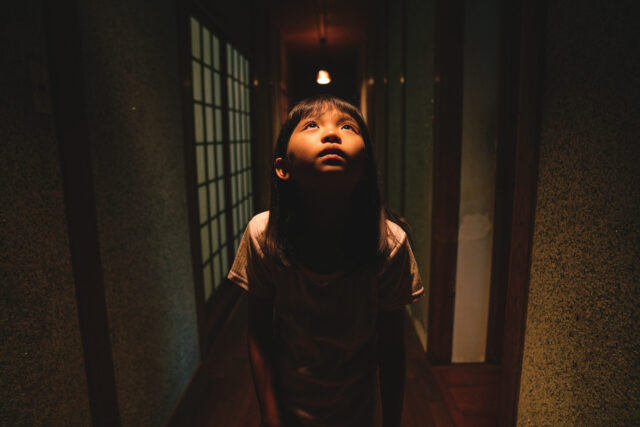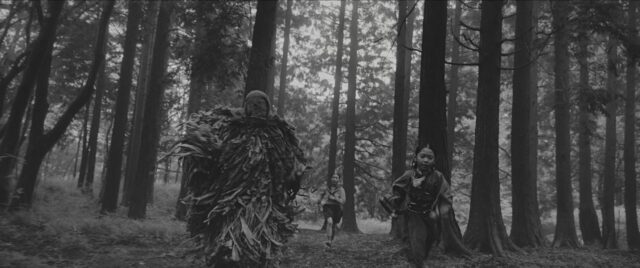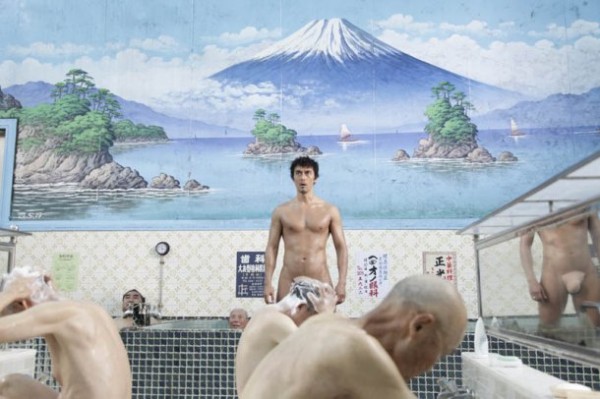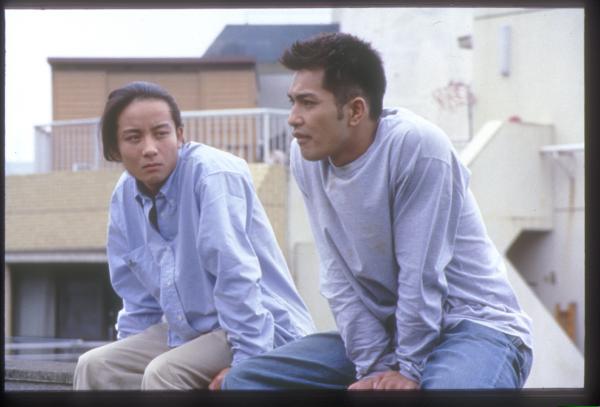
Under the Turquoise Sky is centerpiece of 2023 Japan Cuts fest
JAPAN CUTS: FESTIVAL OF NEW JAPANESE FILM
Japan Society
333 East 47th St. at First Ave.
July 26 – August 6
212-715-1258
www.japansociety.org
Always one of the best fests of the year, Japan Society’s Japan Cuts is back for its sixteenth iteration, consisting of two dozen features and fifteen shorts from across genres, including sci-fi/fantasy, romance, action-adventure, animation, comedy, mystery, thriller, and family drama. The Festival of New Japanese Film opens July 26 with Takehiko Inoue’s The First Slam Dunk, based on his 1990s manga about the Shohoku High School basketball team. The centerpiece is the US premiere of KENTARO’s Under the Turquoise Sky, a road movie set in Mongolia. The festival closes August 6 with the US premiere of Ryuhei Kitamura’s The Three Sisters of Tenmasou Inn, a supernatural drama set in a way station.
Japan Cuts pays tribute to the late composer Ryuichi Sakamoto with a special screening of Elizabeth Lennard’s 1985 documentary Tokyo Melody: A Film about Ryuichi Sakamoto, introduced by Akiko Yano, one of the pianist’s ex-wives, and will be followed by a Q&A with the director. The Next Generation sidebar comprises a half dozen flicks by emerging filmmakers, from actor Hiroki Kono’s debut, J005311, and Yusuke Morii’s Amiko to Ryohei Sasatani’s award-winning, 1960s-set Sanka: Nomads of the Mountain and Yuho Ishibashi’s When Morning Comes, I Feel Empty (followed by a Q&A with the director). Below is a look at several of this year’s selections, with more to be added as the festival continues.

Yuta Shimotsu’s Best Wishes to All weaves between past and present focusing on a frightening recipe for happiness
BEST WISHES TO ALL (みなに幸あれ) (MINA NI KO ARE) (Yuta Shimotsu, 2023)
Thursday, July 27, 9:00
japansociety.org
“Are you happy?” an elderly woman asks her grown granddaughter in Yuta Shimotsu’s creepy existential horror film, Best Wishes to All, making its North American premiere July 27 in Japan Society’s Japan Cuts festival. When a young Tokyo nursing student (Kotone Furukawa) returns to her grandparents’ farm in the Chikuho region, she is greeted by a surprise behind one of the doors. Or maybe it’s not really such a shocker, especially when her parents and little brother arrive and try to tell her what they claim she knew all along but refuses to face. Meanwhile, she rekindles a friendship with an old friend who is decidedly against what her family is doing.
Released earlier this year, Chie Hayakawa’s Plan 75 was a fictional, though frighteningly believable, tale about a government program in which Japanese citizens, upon reaching seventy-five years of age, could receive cash and free cremation in exchange for being euthanized in order to prevent further population growth. In Best Wishes to All, Shimotsu offers a bizarre twist on the idea of life, death, and happiness, involving — well, it wouldn’t be fair to say any more about that. But suffice to say it isn’t pretty. “I’m sorry that young people are sacrificed for old folks like me,” an old woman says to the befuddled nurse. And her grandmother scolds, “I bet you believe the world is good, right? You know nothing about the world.”
Written by Rumi Kakuta based on a story by Shimotsu, Best Wishes to All evokes such films as Takashi Miike’s The Happiness of the Katakuris and Gozu and Takashi Shimizu’s Ju-On series, the latter of which makes sense, as Shimizu is an executive producer on the film. Shimotsu and cinematographer Ryuto Iwabuchi weave between the past and the present as the secret is slowly revealed, but don’t try to think too hard about it, as it doesn’t make a whole lotta sense. Furukawa (Wheel of Fortune and Fantasy) is appealing as the nurse, and the rest of the cast ably do their part playing characters who have no names, adding to the mystery and confusion.

A trio of new friends try to save humanity in From the End of the World
FROM THE END OF THE WORLD (世界の終わりから) (SEKAI NO OWARI KARA) (Kazuaki Kiriya, 2023)
Saturday, August 5, 9:30
japansociety.org
Kazuaki Kiriya’s fourth film in twenty years, From the End of the World — following 2004’s Casshern, 2009’s Goemon, and 2015’s Last Knights — is a rousing thriller, if not quite the epic it aims to be. It’s 2030, and seventeen-year-old Hana Shimon (Aoi Itô) has just lost her beloved grandmother who raised her after her parents were killed in an accident. Instead of sending her to a children’s home, Shogo Ezaki (Katsuya Maiguma) and Reiko Saeki (Aya Asahina), who may or may not be some kind of government agents, lets her stay in her home if she tells them about the dreams she’s been having. Hana often slips into terrifying black-and-white nightmares involving death and destruction, where she is joined by a young girl named Yuki (Mio Masuda) and an unidentifiable creature.
She soon finds out from an old woman with spectacular hair (Mari Natsuki) that the world will be ending in two weeks and that Hana is the only one with the power to prevent disaster. “What’s your impression of the word destiny?” the woman asks Hana. At school, Hana is befriended by Takeru (Jiei Wakabayashi), bullied by Sora (Ai Tominaga), and taught by a teacher played by director Shunji Iwai; she is also pursued by Chief Cabinet Secretary Satoshi Koreeda (Katsunori Takahashi), who has other plans for her. As the clock keeps ticking, a time capsule serves as a critical plot point as past and present merge toward an uncertain future.
Evoking elements of Stranger Things as well as both Takashi Miike (The Great Yokai War) and Hayao Miyazaki (Spirited Away, My Neighbor Totoro), From the End of the World — which Kiriya says will be his final directorial effort — looks fantastic, courtesy of cinematographer Chigi Kanbe, with gorgeous production design throughout as Hana travels through history. Itô (Missing, Gangoose) captures the fear and trepidation experienced by teenagers, whether having to turn in homework, battle a bully, or, well, save the Earth.
“Humans aren’t looking for salvation,” a hooded figure tells Hana. She might not have asked to be in this position, but does she have a choice?

 Adapted from Mari Yamazaki’s popular manga series, Thermae Romae is a bizarre, hysterical tale about the importance of public baths throughout history. In the year 128, architect Lucius Modestus (Hiroshi Abe) has lost his mojo, losing his job to a youngster with more modern ideas and being hounded by his wife to have greater ambition. Down on his luck, he is contemplating his bleak future when he sees a crack at the bottom of a pool, which sucks him into a contemporary Japanese bath house where a bunch of old men are relaxing. The confused fish out of water is amazed by what he sees, from bottled drinks to a clothing basket, and upon magically returning to Rome, he adds these elements to a new bath design that is a huge hit. Soon, every time he goes into water in Rome, he ends up in Japan, bumping into the adorable Mami Yamakoshi (Aya Ueto) and bringing back more ideas, eventually designing bath houses for Emperor Hadrian (Masachika Ichimura), who believes the public bath is a key way to maintain a good relationship with the common people. But despite his success, Lucius can’t help feeling like a fraud, and things only get more complicated when he gets involved in the political machinations of Rome revolving around Hadrian’s successor, either the dedicated Antoninus (Kai Shishido) or self-obsessed womanizer Ceionius (Kazuki Kitamura). Abe is a riot as Lucius, displaying wonderful deadpan flare as he stands naked in front of men and women, refers to the modern-day folk as a flat-faced tribe, and gazes in wonder at a flush toilet. His trips from Rome to Japan evoke the tunnel in Being John Malkovich, complete with appropriately goofy special effects. Writer Shōgo Mutō and director Hideki Takeuchi keep things moving at a playful pace, celebrating social interaction as well as potential romance, complete with a fun Greek chorus of Japanese bath lovers. A sequel has just come out in Japan, but you can catch the first film on July 14 at 5:15 as part of the annual “Japan Cuts” series at Japan Society, which runs July 11-21 and includes such other works as Takashi Miike’s Lesson of the Evil, Yukihiro Toda’s There Is Light, Yuki Tanada’s The Cowards Who Looked to the Sky, Mika Ninagawa’s Helter Skelter, and Keishi Otomo’s Rurouni Kenshin, many of which are copresentations with the Film Society of Lincoln Center’s New York Asian Film Festival.
Adapted from Mari Yamazaki’s popular manga series, Thermae Romae is a bizarre, hysterical tale about the importance of public baths throughout history. In the year 128, architect Lucius Modestus (Hiroshi Abe) has lost his mojo, losing his job to a youngster with more modern ideas and being hounded by his wife to have greater ambition. Down on his luck, he is contemplating his bleak future when he sees a crack at the bottom of a pool, which sucks him into a contemporary Japanese bath house where a bunch of old men are relaxing. The confused fish out of water is amazed by what he sees, from bottled drinks to a clothing basket, and upon magically returning to Rome, he adds these elements to a new bath design that is a huge hit. Soon, every time he goes into water in Rome, he ends up in Japan, bumping into the adorable Mami Yamakoshi (Aya Ueto) and bringing back more ideas, eventually designing bath houses for Emperor Hadrian (Masachika Ichimura), who believes the public bath is a key way to maintain a good relationship with the common people. But despite his success, Lucius can’t help feeling like a fraud, and things only get more complicated when he gets involved in the political machinations of Rome revolving around Hadrian’s successor, either the dedicated Antoninus (Kai Shishido) or self-obsessed womanizer Ceionius (Kazuki Kitamura). Abe is a riot as Lucius, displaying wonderful deadpan flare as he stands naked in front of men and women, refers to the modern-day folk as a flat-faced tribe, and gazes in wonder at a flush toilet. His trips from Rome to Japan evoke the tunnel in Being John Malkovich, complete with appropriately goofy special effects. Writer Shōgo Mutō and director Hideki Takeuchi keep things moving at a playful pace, celebrating social interaction as well as potential romance, complete with a fun Greek chorus of Japanese bath lovers. A sequel has just come out in Japan, but you can catch the first film on July 14 at 5:15 as part of the annual “Japan Cuts” series at Japan Society, which runs July 11-21 and includes such other works as Takashi Miike’s Lesson of the Evil, Yukihiro Toda’s There Is Light, Yuki Tanada’s The Cowards Who Looked to the Sky, Mika Ninagawa’s Helter Skelter, and Keishi Otomo’s Rurouni Kenshin, many of which are copresentations with the Film Society of Lincoln Center’s New York Asian Film Festival.